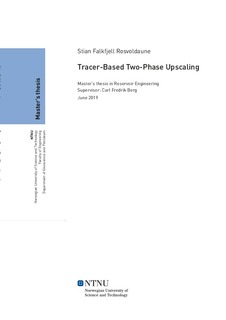| dc.contributor.advisor | Berg, Carl Fredrik | |
| dc.contributor.author | Rosvoldaune, Stian Falkfjell | |
| dc.date.accessioned | 2019-10-31T15:20:29Z | |
| dc.date.available | 2019-10-31T15:20:29Z | |
| dc.date.issued | 2019 | |
| dc.identifier.uri | http://hdl.handle.net/11250/2625929 | |
| dc.description.abstract | Nøyaktig oppskalering av strømning i reservoar er et viktig tema i olje og gass industrien på grunn av de store beregningskostnadene assosiert med å utføre simuleringer på komplekse reservoarmodeller. Målet med en oppskalering er å fjerne noen av de romlige detaljene til de komplekse modellene ved å erstatte celler med blokker som har homogene egenskaper. Oppskalering klassifiseres ofte basert på parameteren som blir oppskalert og hvilken type informasjon som brukes i oppskaleringen. Hovedfokuset i denne studien er oppskalering av parametere i tofasestrøm, nærmere bestemt relativ permeabilitet.
En av de vanligste oppskaleringsteknikkene for tofasestrøm er oppskalering ved stabil tilstand. Ved stabil tilstand neglisjeres tidsavhengighet slik at et sett med forenklede ligninger er anvendbare. Den mest beregningskrevende delen av oppskalering ved stabil tilstand er å finne metningsfordelingen som brukes til å finne den oppskalerte relative permeabiliteten. På bakgrunn av dette blir en ny metode for å finne metningsfordelingen ved stabil tilstand introdusert i denne studien. Metoden refereres til som sporpartikkelbasert oppskalering og baseres på å konvertere metningsfordelinger fra mer beregningseffektive sporpartikkelsimuleringer til faktiske metningsfordelinger. Konverteringen gjøres ved å bruke det som vil bli referert til som sporpartikkelfunksjoner, som er funksjoner som er generert av data fra numeriske eksperimenter.
Det vil bli vist at bruken av sporpartikkelsimuleringer til å finne metningsfordelingen ved stabil tilstand gir lik nøyaktighet eller feil innen noen få prosent sammenlignet med en eksisterende tofase oppskaleringsteknikk ved stabil tilstand og referanseløsninger fra den opprinnelige simuleringsmodellen. Hovedegenskapen til den sporpartikkelbaserte oppskaleringen er at denne nøyaktigheten oppnås med en mye lavere beregningskostnad enn for de eksisterende tofase oppskaleringsteknikkene ved stabil tilstand.
Det vises også at sporpartikkelfunksjonen ikke er modellspesifikk siden nøyaktige resultater oppnås ved å bruke funksjoner som er generert basert på andre modeller i modellen som benyttes her. Det faktum at funksjoner fra andre modeller gir nøyaktige resultater indikerer at nøyaktigheten av de oppskalerte resultatene fra den sporpartikkelbaserte oppskaleringen avhenger mer av formen på funksjonen enn hvilken modell funksjonen er basert på. Dette eksemplifiseres ved at funksjonens form endrer seg med tid og at mer nøyaktige resultater kan forventes dersom tidsavhengighet introduseres i funksjonen. Undersøkelser av hvordan funksjonens form påvirker resultatene fra den sporpartikkelbaserte oppskaleringen og om andre modeller gir forskjellige resultater er derfor hovedanbefalingen for videre arbeid. | |
| dc.description.abstract | Accurate upscaling of subsurface flow is an important topic in the oil and gas industry due to the computational power requirements of performing simulations on complex geo-cellular models. The aim of an upscaling procedure is to remove some of the spatial detail of the complex models by replacing grid cells with blocks of homogeneous properties. The upscaling procedures are often classified based on the parameter that is upscaled and which type of information that enters the procedure. The main focus of this study will be on the upscaling of two-phase flow parameters, specifically the relative permeability.
One of the most common techniques for upscaling two-phase flow is steady-state upscaling. In steady-state upscaling, time-dependency is neglected such that a set of simplified equations are applicable. The most computationally demanding part of steady-state upscaling is finding the saturation distribution at steady-state which is used to calculate the upscaled relative permeability. To that end, this study introduces a new method referred to as tracer-based upscaling for finding the steady-state saturation distribution, which is based on converting saturation distributions from more computationally effective tracer simulations to actual saturation distributions. The conversion is performed by using what will be referred to as tracer functions, which are functions generated based on data from numerical experiments.
The use of tracer simulations to predict the saturation distribution is shown to provide equal accuracy or errors within a few percent with respect to an existing steady-state two-phase upscaling procedure and reference solutions from the original simulation model. The major attribute of the tracer-based upscaling is that this accuracy is obtained at a significantly lower computational cost than the existing steady-state two-phase upscaling procedures.
It is also shown that the tracer function is not model specific through the fact that accurate results are obtained by using functions generated from other models in the one used here. The fact that functions from other models gave accurate results indicates that the accuracy of the tracer-based upscaled results depend more on the shape of the tracer function than which model the function is based on. This is exemplified through the fact that the function's shape changes with time, and that more accurate results would be obtained if time-dependency was introduced to the function. Further investigations on how the shape of the function affects the results and if other models give different results are therefore the main recommendation on further work. | |
| dc.language | eng | |
| dc.publisher | NTNU | |
| dc.title | Tracer-Based Two-Phase Upscaling | |
| dc.type | Master thesis | |
